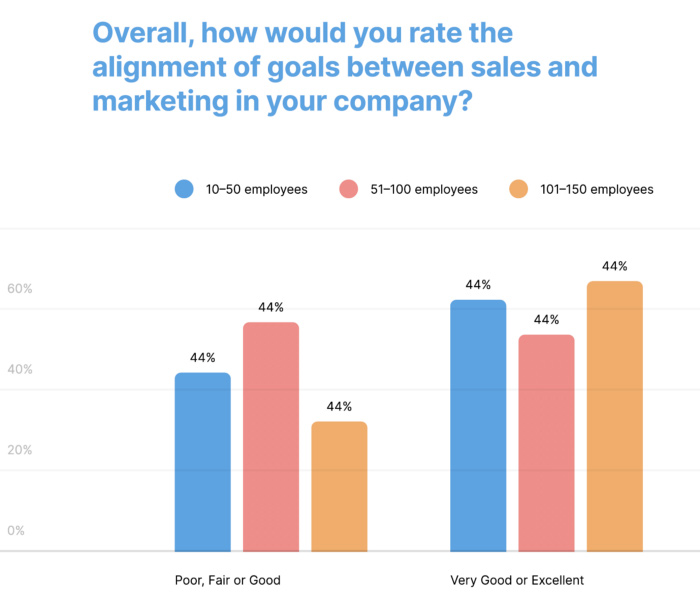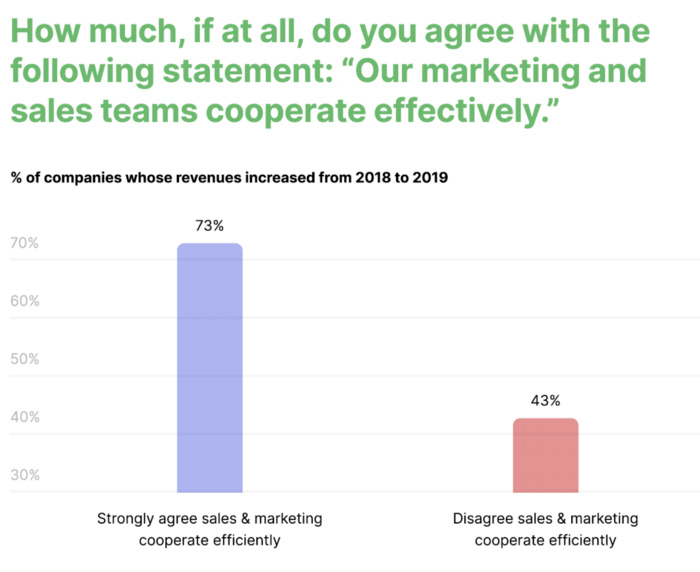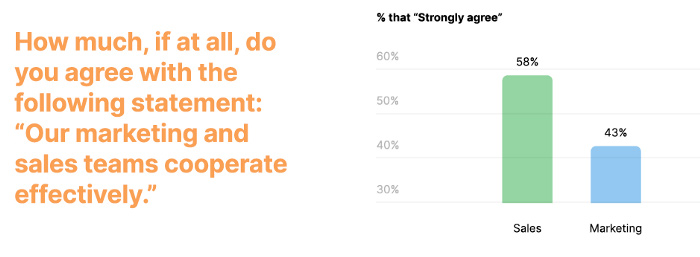I have been fortunate during my 10 years in B2B marketing to work with some incredible sales and revenue professionals, and I’ve learned a thing or two about how to build rewarding alignment between our teams. Frankly, I’ve never really understood the narrative around poor alignment; tension between sales and marketing doesn’t need to exist at all. Not if you do the right things.
by Carrie Shaw
But this lack of alignment is prevalent, certainly if you look at the results of the revenue marketing research we commissioned in partnership with revenue marketing automation platform Outfunnel.
This research, conducted in December 2020 with responses from over 300 sales and marketing professionals in B2B companies large and small, tells us that nearly half of all teams are not aligned in terms of goals.

Nearly half! What a missed opportunity. And what a difficult environment that creates. It’s hard to imagine being a marketer who constantly experiences tension with those for whom he or she is delivering leads. And it’s hard to imagine being a sales professional who is dependent on leads and doesn’t believe in their quality.
That is undoubtedly why the research also shows that companies with well-aligned teams see 73% more growth than those without.

Furthermore, the misalignment signals differing opinions of what is happening across teams. More marketers think sales doesn’t understand what’s important to marketing than the reverse.

To me, the formula for building alignment is pretty straightforward. But bear in mind that it takes more soft skills than hard skills. We need to be good humans to each other, in a nutshell.
We need to apply some of the tenets of personal relationship-building to arrive at a kinship that will drive business growth and offer all of us more satisfying careers.
Here are 5 ways you can create a culture of alignment between sales and marketing in your organization. While I write this from the perspective of a marketer, I am certain this works both ways. Do note that this is applicable to B2B companies where there is at least a portion of high-touch sales that contributes to overall revenue.
Push marketing KPIs as far down-funnel as you can.
I’ve come into more than one organization where my first move as CMO was to transition from MQLs to SQLs as the north star metric for measuring marketing performance. MQLs are meaningful only because a proportion of them become sales qualified, and marketers need to understand that conversion rate so they can manage channels. But marketers should never be measured on the number of MQLs they generate. Never.
Most people balk at this, because they say they can’t control what sales does when they get leads. Some have taken the half-measure of adopting the sales-accepted lead. I don’t think it goes far enough. Saying “it’s out of our hands” is a fallacy that stems from a lack of trust (more on that later). Quality leads build pipeline. Period.
Making the SQL your main KPI forces you to look at the quality of your MQLs, not the quantity.
And that’s the crux of the argument. Making the SQL your main KPI forces you to look at the quality of your MQLs, not the quantity. You’ll spend more time thinking about reaching your intended audience and their needs, rather than adopting a spray and pray approach or doing keyword searches to see what’s not ranking — whether it’s meaningful to your audience or not. You’ll spend more time thinking about conversion rates and lead nurturing. You’ll spend less time trying to spend your way out of a jam. Perhaps most importantly, you’ll build a closer and stronger relationship with your sales team as you realize how intertwined the two of you really are. These are all things that are great for your business.
What ultimately happens when I make this switch is that marketers realize how differently they operate when they’re focused on pipe gen versus lead quantity. It literally changes the job in all the right ways.
Watch for win rates that are too high
Yes, you read that right. Too high. When win rates from opportunity to close are north of 50%, there is a problem. It means sales is qualifying opportunities too far into the sales process. That leads to three problems: 1) Weakness in forecasting. 2) Leaving money on the table by cherry picking only the deals that are easy to close and 3) Not closing the feedback loop for marketing to improve pipeline generation.
Typically, I like it when sales creates the opportunity at the moment the demonstration is set. Any earlier doesn’t show enough intent from the prospect. Any later and you’re missing out on an opportunity to demo a prospect who may simply be busy, and has to be pushed a little to bring your solution back to the forefront.
This happens to me as a consumer, and when it does, I actually thank the sales person for staying on top of things. I’ve said a few times: “I really want to do this; I just need to find the right time. Thank you for pinging me to remind me how important this is.” Sure, the sales cycle is longer. But it’s not actually harder.
The other reason I like to create the SQL at the moment of demo set is because it is truly qualified to be a stage 1 opportunity at that point. Sales has gotten a hold of the prospect, they have communicated on early qualifying use cases, and the prospect has agreed to a longer demonstration. Those are good signals that marketing has done their job.
Explore a revenue operations strategy
Some businesses — especially the larger ones — have marketing operations and sales operations teams. Marketing ops reports into marketing; sales into sales.
Why is this? So that marketing ops can make marketing successful and sales ops can make sales successful. Makes sense right?
Wrong. It can create further silo-ing of the departments. In fact, it can break key automations. Think about it this way. Marketing operates out of the marketing automation platform; sales out of the CRM. Sales has integrated email in the CRM and reps create their own sequences to nurture leads. Marketing has messaging sequences to nurture leads also.
Can you see how quickly this can get terribly complicated?
And let’s not forget about Customer Success. Not the focus of this piece, but operationally they need to be connected as well. A good rev ops team will take care of marketing, sales, AND CS so the entire customer journey — even through advocacy — is consistent.
At one organization I worked for we discovered there were five email automation systems in place. Mailchimp, Salesforce, Zendesk, Sendgrid, and some old hard-coded emails coming out of the product. How will you ever nurture your prospects in the right way like this?
Right now we are experimenting with a centralized operations group that serves both teams equally, and I like it. The operations resources have a birdseye view of all of our martech and sales tech stacks, and work full-funnel in everything they do.
I will acknowledge that determining who this team reports into is a challenge, and resourcing is tough. But at the very least, creating the cross-functional department is a great start.
Recognize that your teams are in service to each other
Here is where everyone needs a dose of humility, if they don’t already have it. We’re all in service of business growth, and business growth is mostly output by sales.
As a CMO I am in service to my sales team. I know this; I approach my role from this position, and I coach my team on this front. It leads to a culture of respect, and I am rewarded with great cooperation and reciprocation. Everything marketers do is in service to sales. Even the brand work. Even the PR. Even the customer marketing work. That doesn’t mean everything you do is about lead generation. But really? Everything you do is at least indirectly about lead generation. We’re all trying to grow top-line revenue here.
So don’t be that marketer who thinks poorly of sales because “they don’t call my leads.” Think bigger. Be the marketer who thinks “how can I create indisputably great pipeline?”
Salespeople have to recognize that marketers can’t guess what makes a good lead. I hear marketers say “they never call my leads” and I hear salespeople say “their leads are no good.” The truth is somewhere in between. No pipeline will ever be perfect. The secret is for it to be good enough so that sales trusts it and marketing trusts sales to use it.
Sales’ purpose in life is to close business. To do that, sales has to deliver crisp, unbiased, thoughtful data back to marketing. They must carve out time for their lead providers expressly to communicate critical details about the leads they’re getting. Any sales leader who tells you he or she can’t make this a priority is not a good sales leader.
In delivering this critical information, salespeople must watch for bias. They can’t only bring bad news to marketers. Yes, by all means, tell us about the leads you’ve disqualified because they were on the wrong operating system. But please also tell us about the ones that led to 5-figure deals!
Because when we know what works, we’ll go get more of it. We’ll use the successful use cases to drive messaging. We’ll find more prospects from that channel. We’ll increase spend to that landing page. We can do a lot with positive feedback. We won’t get complacent!
In short, for alignment and peace, both teams need to realize they’re in service to each other. There is no template or guide or metric or spreadsheet that’s going to make you realize this. It’s a frame of mind that needs to permeate throughout the organization.
Lead with empathy and heart, and work hard to develop trust
Sales leaders who miss targets bear the weight of the world on their shoulders. Sales leaders who hit targets often get rewarded with higher targets. It’s a really hard job.
I have deep empathy for sales professionals. I would not last a day in the job. I would be so stressed about hitting quota that I’m quite sure I would end up curled up in a ball under my desk. Sales leaders who miss targets bear the weight of the world on their shoulders. Sales leaders who hit targets often get rewarded with higher targets. It’s a really hard job.Especially in this day and age where there are at least dozens, and sometimes hundreds of choices for prospective buyers.
Salespeople are asked to deliver even when the product isn’t up to snuff. Even when the market isn’t cooperating. When it is high summer and everyone is on holiday. It’s relentless. Marketers should operate from a place of understanding this challenge.
As for sales — they need to realize that good marketers feel as stressed about their quotas as sales does. I lose sleep when I don’t hit pipeline targets. I tear my hair out when I can’t figure out why SQLs are down in a month where they should be up. Even if you are (currently) working with a marketing team that is too focused on the top of the funnel, ask yourself why that is. Because it appears more successful. It’s a cover for a team that doesn’t feel empowered to report down-funnel because they have no idea what happens after the MQL is created. This team is afraid of failure too, so they try to make everything look good by crowing about MQL volume.
Understand that each of us is trying to succeed in our own ways. That’s a good place to start.
Tactics that work
I’ll close this out with several tactical ideas that have worked well to support the key points above. My hope is that you’ll pick and choose from this list a few that will work for you.
- Pipeline review. Sales and marketing leaders tend to have weekly meetings to look at monthly forecast, month-to-date performance, or similar. Use part of this meeting to review top deals in the pipeline and what is needed to close.
- Win/loss review. Then hold monthly or bi-monthly win/loss meetings. Convene your entire sales and marketing teams after month-close. Have each sales person take 5 minutes to review top 2–3 wins and top 2–3 losses. For each, cover the customer profile, the business vertical, the customer use case, and why the deal was won or lost.
- Sales + marketing buddy system. Pair up a salesperson and a marketer and see what happens. Don’t give them a mandate other than to improve team alignment. See how it goes. This resulted in a funnel optimization that unlocked 10% additional SQLs in one of the companies I worked for.
- Present a united front for upper management. We are often asked to deliver departmental presentations to executives. Rather than a marketing presentation, followed by a sales presentation, I like to work with my sales leader to create a joint marketing/sales presentation and we co-deliver it. This absolutely forces alignment. No CMO/CRO pair would go in front of the CEO with a joint deck that showed high MQLs and blown revenue targets.
- Seat changes. This will be more applicable once we’re back in office. With more hot-desking available, I always encourage my team to sit next to sales (and do so myself). Listening to their conversations by osmosis is a powerful way to develop empathy and to learn more about the customer. This is harder to do right now, but you can always ask for recordings of calls and listen at 1.5x speed. It’s efficient and helpful, if not quite as enjoyable.
You can and should seek to eliminate any tension between your sales and marketing teams for the health of your business. There is no value to this tension — unlike other types we experience in the workplace which may ultimately deliver better results. Be a modern worker, and enjoy trusting, empathic relationships with shared goals and values. You’ll be happier for it, and your organization will be more successful.
 Carrie Shaw is SaaS CMO, currently at Copper CRM.
Carrie Shaw is SaaS CMO, currently at Copper CRM.This article originally appeared in Medium Startup Grind. Photo by Alice Yamamura on Unsplash.













